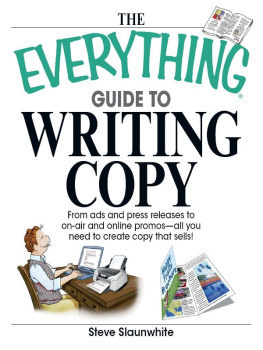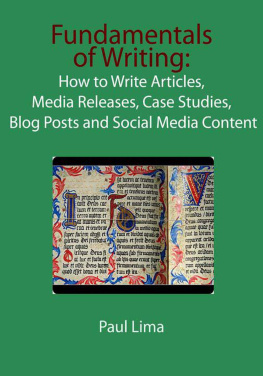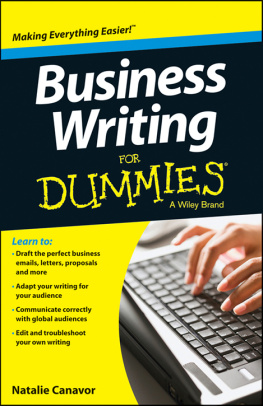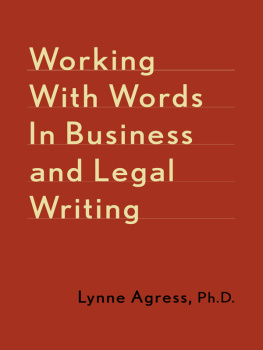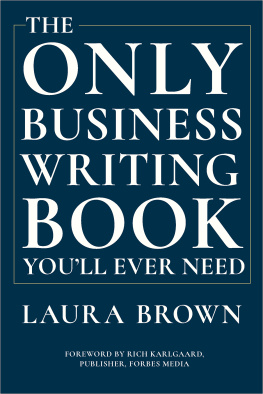Nicely Said
Writing for the Web with Style and Purpose
Nicole Fenton and Kate Kiefer Lee
NICELY SAID
Writing for the Web with Style and Purpose
Nicole Fenton and Kate Kiefer Lee
Peachpit Press
www.peachpit.com
To report errors, please send a note to
Peachpit Press is a division of Pearson Education
Copyright 2014 by Nicole Fenton and Kate Kiefer Lee
Project Editor: Nancy Peterson
Production Editor: Tracey Croom
Development Editor: Margaret S. Anderson/Stellarvisions
Copyeditor: Gretchen Dykstra
Proofers: Liz Welch, Gretchen Dykstra
Compositor: Kim Scott/Bumpy Design
Indexer: Rebecca Plunkett
Cover Design: Alvin Diec
Interior Design: Kim Scott/Bumpy Design
Notice of Rights
All rights reserved. No part of this book may be reproduced or transmitted in any form by any means, electronic, mechanical, photocopying, recording, or otherwise, without the prior written permission of the publisher. For information on getting permission for reprints and excerpts, contact . All artwork in this book is copyrighted by the owner and used with permission.
Notice of Liability
The information in this book is distributed on an As Is basis without warranty. While every precaution has been taken in the preparation of the book, neither the author nor Peachpit Press shall have any liability to any person or entity with respect to any loss or damage caused or alleged to be caused directly or indirectly by the instructions contained in this book or by the computer software and hardware products described in it.
Trademarks
Many of the designations used by manufacturers and sellers to distinguish their products are claimed as trademarks. Where those designations appear in this book, and Peachpit Press was aware of a trademark claim, the designations appear as requested by the owner of the trademark. All other product names and services identified throughout this book are used in editorial fashion only and for the benefit of such companies with no intention of infringement of the trademark. No such use, or the use of any trade name, is intended to convey endorsement or other affiliation with this book.
ISBN 13: 978-0-321-98819-5
ISBN 10: 0-321-98819-1
9 8 7 6 5 4 3 2 1
Printed and bound in the United States of America
Contents
Foreword
If youre not a professional writer, The Fear usually strikes early: either at the very idea of needing to write, or at the moment when its time to begin typing and the terror of the blank page leaps up and freezes your hands on the keyboard. Many (most?) professional writers feel the same thing, along with bonus terrors near the midpoint of a project (Why did I ever agree to this?!) and at the very end (This is probably completely incomprehensible and I cant even tell anymore).
Much of that fear arises because our task is so unclear. Writing is something were rarely taught, beyond mechanics and a little instruction about the five-paragraph essay. But writingespecially in a business contextis a craft with principles and methods that have little to do with grammar and mechanics and everything to do with identifying and meeting readerly needs. Even if they dont realize it, experienced writers understand and rely on those principles and methods, but its very difficult to find introductions or explanations that deal with them head-on.
Thats the first reason this book is such a joy. Whether you write full-time for a big agency or juggle a dozen hats at a tiny nonprofit or startup, this book will give you starting points, help with common web writing questions, and most importantly, a coherent and repeatable approach to writing. In the chapters that follow, youll find step-by-step guidance through the stages of research, writing, and revision, as well as detailed advice on developing a lively, appropriate voice and tone. Youll also find in-depth discussions of dozens of weird little problems that trip up even the most experienced writers: things like handling the corporate we/us without sounding creepy, using humor without alienating readers, and navigating the strangely worded waters of legal copy. (And the chapter on clear, ethical, humane marketing is worth the price of the book all by itself.) In short, Kate and Nicole actually explain the things most of us had to absorb from context or learn by getting it wrong.
The second wonderful thing about the book is its unapologetic, matter-of-fact belief that humanness matters as much as formal expertise, and that compassion trumps cleverness. The result is a writing guide that grounds its wealth of practical advice in empathy for readers and their needsand really digs into what that means, and how to go about understanding the culture, vocabulary, and sensibilities of the communities you write for.
Between them, Kate and Nicole have written for many of the webs most valuable and respected companies. Their commitment to clarity and kindness is the result of their experience, and it makes them extraordinary teachers. The sum of their efforts is an orderly, comprehensive method for accomplishing each writing project you undertake: not paint-by-numbers, but a flexible process within which you can focus all your attention on your goals, your readers, and their needs.
Good writing is always hard, but good guidance makes it a thousand times easier. I cant imagine better guides.
Erin Kissane
Author of The Elements of Content Strategy
Director of Content, Knight-Mozilla OpenNews
Style Matters
You cant see your readers. You dont know how theyre feeling or what theyre going through. You cant watch their expressions or make eye contact with them. So writing for them is a little bit of a puzzle.
Most companies fail at this. They dont know how to talk to people like real human beings, and their content is confusing or unhelpful. Sometimes its even offensive. And thats a genuine problem, because theres no shortage of other things people can do or read online. You need readers to trust you.
With this book, our goal is to unravel the mysteries of the writing process and help you create useful and meaningful web content. Part of that is about asking the right questions. Part of it is about practicing and reading your work aloud. And part of it is about balancing your goals with what your readers need each step of the way.
Whether youre a writer, editor, blogger, content strategist, designer, developer, or small business owner, this book is for you. If youre new to the field, well introduce you to the types of content that go into making a website. If youre an experienced writer looking to brush up your skills, well help you take your voice further and thread your communications together.
In the chapters that follow, well show you how to write for the web with a consistent style and clear sense of purpose. Youll learn how to plan a writing project, define realistic goals, and work toward your mission. Youll know how to adapt your tone to fit the situation and match your readers feelings. Youll have a set of principles to guide your writing. Youll be ready to teach these concepts to your team with a simple style guide. And youll know when to break the rules.
This is not a handbook, a playbook, or a workbook. What follows is our best advice from years of writing for the web professionally. As you read, feel free to skip around to the parts that apply to what youre doing right now. After all, writing isnt a linear process. Theres no real beginning, middle, or end.
We put a heavy emphasis on the fundamentals, ongoing practice, and value of writing. We wont go into detail about related disciplines like content strategy, information architecture, search engine optimization, or interaction design. But we included a list of our favorite resources in the Further Reading section.



